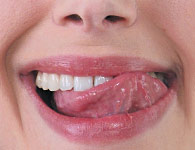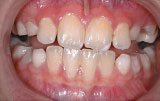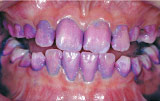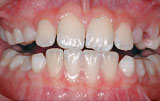Daily Oral Hygiene
Easy Habits For Maintaining Oral Health
(Continued)
How Do I Know I’m Doing It Right?
Here are some easy ways to get feedback and positive reinforcement:
 |
| “Tongue test” to check for slippery clean feeling at the gum line after plaque removal. |
The Tongue Test. “Slick at the gum line!” Have you noticed that after a professional dental cleaning, your teeth feel slick and smooth down to the gum line? That’s how they should feel every time you brush your own teeth.
Use your tongue to feel at the gum line, and see if the tooth surfaces feel smooth and slick throughout your mouth. Try the upper front teeth first, which is where most people do the best job because it’s easiest to reach. Then, try the more difficult areas, such as the tongue side of the lower back teeth.
Floss check. “Squeaky clean!” If you run the floss up and down a tooth surface, it should squeak if you’ve removed all the plaque possible. That “Squeaky clean” feeling is easier to achieve with un-waxed floss.
Getting To That Loving Feeling
If you are unable to successfully judge, or remove all the bacterial plaque, don’t be disappointed or frustrated — everyone has different levels of dexterity. Remember, it’s important to reduce your daily plaque level, even if you can’t remove it all. If you can decrease the plaque level on your teeth each day, then you’re still more likely to keep your teeth and gums relatively healthy for life.
 |
| 11 year old child before disclosing solution is used. To the naked eye, it is impossible to see plaque (bacteria). |
 |
| Same child after disclosing solution is used. The purple stain highlights older bacterial plaque and the pink newer plaque. Are you surprised? |
 |
| Same child after plaque removal. Notice all the stain (plaque) has been removed. |
| Photos provided by Dr. Garry A. Rayant |
Cautions:
Bleeding. It’s important to note that healthy gums do not bleed. Bleeding signals inflammation of the gums, i.e. gingivitis. So take bleeding that lasts more than a few days seriously. If you note bleeding after brushing or flossing, it’s a sign of inflammation, even in the absence of pain. If you do notice minor bleeding, it should go away after a few days of using the new brushing and flossing methods we’ve described. If it doesn’t, or if it’s painful, consult your dentist.
Proof Positive:
Seeing Is Believing. Disclosing solutions are simple dyes that can stain plaque and make it visible. Your dentist or hygienist may have used them in your treatment before, together with an “index” or charting system to quantify your behavior at your dental visits. Disclosing solutions give your dentist a regular measure of your dental health habits — similar to the regular blood pressure readings you undergo during a visit to the doctor’s office.
Healthy Oral Hygiene Habits. After practicing the techniques for a while, your hygiene “behavior” should become automatic and unconscious. But, you’ll also have adopted new ways to check how well you’re doing (tongue test). Then you should be able to build oral hygiene habits into your day efficiently, and you’ll be on the road to a lifetime of oral health.
Visit Your Dentist Your dentist is the ultimate check for knowing how effective you’ve been with your hygiene habits — it’s mirrored in your oral health.
DO — Try This At Home
Are your teeth and gums healthy? If you have questions about your dental health and how to practice good oral hygiene, don’t be afraid to ask. Your dentist can discuss the state of your oral health with you — and offer some good pointers for dental health habits to practice at home.

